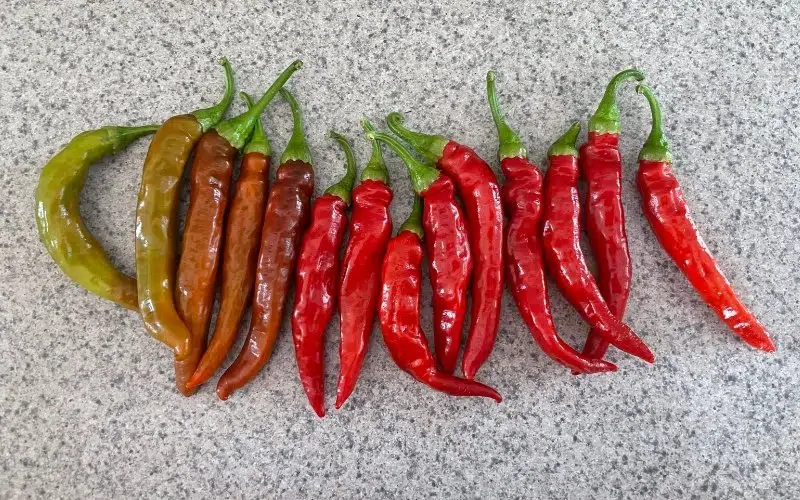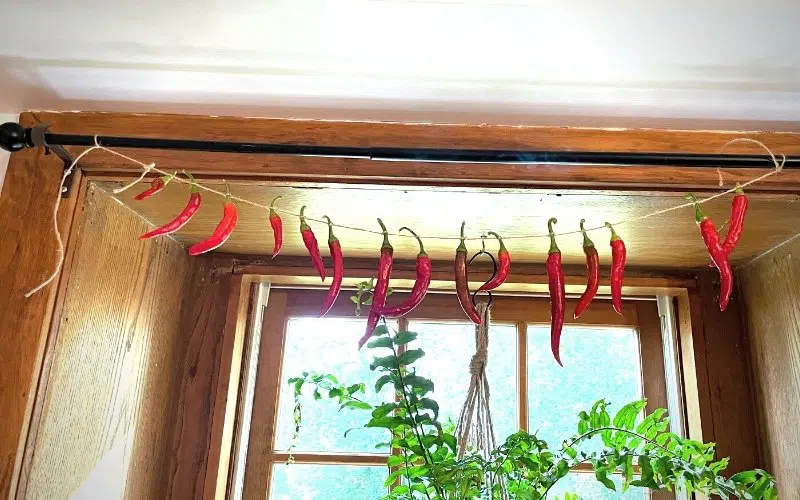Cayenne peppers have become one of my favorite hot peppers to grow in the garden. They’re pretty easy to grow and are very prolific, meaning they give you a lot of peppers for the amount of work you put in.
When you pick your cayenne peppers, there are quite a few things you can do with them. You can eat them fresh on pizza’s or in soups, you can freeze them, or you can dry them which is my favorite method.
Dried cayenne peppers give you a lot of options for using them later, but the two most common are red pepper flakes and cayenne pepper powder.
Let’s walk through a few ways you can dry them and make your own cayenne pepper powder.

How to Dry Cayenne Peppers
There are 3 methods for drying cayenne peppers that I’d recommend.
Air Drying Cayenne Peppers
My favorite method is to air dry peppers. It’s reliable, and doesn’t require many tool or resources to do.
- Time Needed: 2-4 weeks
- How Easy is it: Very easy
- Required Tools: Jute, or garden twine
Air drying cayenne peppers comes in a few different forms. Some people like to evenly space them out in a cardboard box and leave in a dry location for a while. With the method, you need to make sure you’re regularly turning them, or shaking the box up so the moisture can move around and escape.
My favorite method is to tie them together with garden twine or jute, and hang them near the windows in the kitchen. It adds some nice freshness to the space, and is the most consistent method I’ve tried.
1. Wash and dry your cayenne peppers
You want to start off with clean peppers to make sure no lingering dirt or pests made it indoors when you harvested them.
Once clean, pat them dry with a kitchen towel or paper towel.
Do not remove the stems, as this is what you will tie them up with.
2. Tie your peppers to the twine
Tying your peppers to the twine is pretty simple.
While there are more complicated methods of making full blown ristras, I just usually tie each one to the twine by making a loop, hooking it around the stem and pulling tight.
Space them out just a little bit and create another loop for the next pepper.
Some people use buttons and other fancier methods to thread peppers together, but this is quick and it works!

How to Dry Cayenne Peppers in a Dehydrator
Dehydrating peppers is another method you can use to dry them. It’s a much faster method, but does require you to have a food dehydrator.
- Time Needed: 6-8 hours
- How Easy is it: Easy
- Required Tools: A dehydrator (this is my favorite)
1. Wash and pat dry the peppers
Washing your peppers helps remove and dirt, debris, or pests that might be lingering around. Make sure to dry them off a bit so they dehydrate more evenly.
2. Remove the green stems
Removing the stems will ensure a more even dehydration process, and allow space for the moisture to escape.
3. Cut your peppers longways
This allows the dehydrator to more effectively dry every part of the pepper, removing any and all moisture. If you don’t slice them, this process will take longer, and you’ll need to be more careful to watch for mold when storing the peppers in an airtight jar.
4. Remove the seeds (optional)
Some people like to remove the seeds before dehydrating peppers. If you’re making red pepper flakes, I’d leave them in, but if you’re making a powder or don’t like your peppers super spicy you can remove them.
5. Dehydrate for 6-9 hours at 120°F
This process takes quite a few hours to complete, but you do want to make sure you’re checking your peppers regularly to see if they’re done. Cayennes are thin walled peppers so times may vary here.
How to Tell When They’re Done Dehydrating
Your peppers will crack and break apart easily when they are completely dry. If they have any give, or bend at all, put them back into the dehydrator.

6. Put Those Peppers to Use! (Or Store Them)
Your peppers are ready to be ground up or stored for later. More on how to store them later in this post.
How to Dry Cayenne Peppers in the Oven
You can also dry cayenne peppers in the oven in a very similar fashion as the dehydrator.
1. Preheat oven to lowest temperature
Preheat your oven to its lowest temperature setting. Most ovens go down to about 140°-160°, but if it goes lower then use that setting.
The higher the temperature, the shorter to drying process, but the higher the temperature, there is a good chance your peppers might actually start to cook in the oven, so we want the lowest setting possible.
2. Wash and dry your cayenne peppers
3. Cut peppers in half
Remove the stems, and cut your peppers in half lengthwise. This will allow the oven to fully dry every part of the pepper.
4. Place peppers on a baking tray or sheet pan
Make sure your peppers are evenly spaced and not touching one another. This will help speed up the drying time and leave you with a more even dry.
5. Place peppers in the oven
The time it will take to dehydrate your peppers will vary based on the temperature setting, your specific stove, and the environment you live in.
It usually takes between 7-10 hours to fully dehydrate, but you’ll want to keep an eye out and make sure you don’t leave them in there too long. You want to peppers to crack when you apply pressure. If they give at all, put them back in for another 30-60 minutes.
Can You Air Dry Cayenne Peppers?
Absolutely! Air drying cayenne peppers is my personal favorite method. It’s simple, and you can leave them hanging until you need them, which is a nice perk. It also reminds me of living in Arizona and seeing people with dried cayennes around their kitchens.
What to Do With Cayenne Peppers After Picking?
There are some unique ideas of what to do with cayenne peppers after you harvest them from the garden, or if you have a bunch leftover.
You can use dried chili peppers to make red pepper flakes, cayenne powder, cayenne pepper hot sauce, chili oil, or add them to a rub and spice up your chicken, beef or pork.

1. Cayenne Pepper Powder
You can make your own chili powder using dried cayennes! I put this on all kinds of stuff, like pizza and pasta.
Remove the stems and seeds (optional) and throw your cayenne peppers in a blender or food processor. Blend until you get the desired texture, close to a fine powder.
Pro tip: Let things settle before you open up the blender, or else you might be sneezing for the next hour.

2. Red Pepper Flakes
I didn’t realize that red pepper flakes came from cayenne peppers, but it’s true! Red pepper flakes are great for pizza, pastas, and my favorites – guacamole and avocado toast!
Put your peppers (minus the stems) in a food processor, and grind it up until you get it to a good consistency. You can also use a mortar and pestle to grind them up by hand, which can be fun. A spice grinder is another good option.
Again, let things settle down before opening up the lid of the food processor. 🙂
Storing Dried Cayenne Peppers
Storing your cayennes is one of the most important steps. If not stored properly, they can attract mold, and all of that time spent growing them and drying peppers was for nothing.
Whether you are storing dehydrated peppers or ones you’ve air dried, you want to make sure all of the moisture is taken out. After you dry peppers, leave them out without a lid for a few days. While it may take away a small amount of their storage life, it’s better than coming across mold in a few days!

I like to check on my jars of dried peppers every couple of days after I first put them in the pantry.
If I see any condensation, I open the lid back up and set it on the counter. Then I’ll shake it up every few days to make sure I’m redistributing the moisture. That’s all there is to it!



This is exactly what I was looking for! Thank you very much.